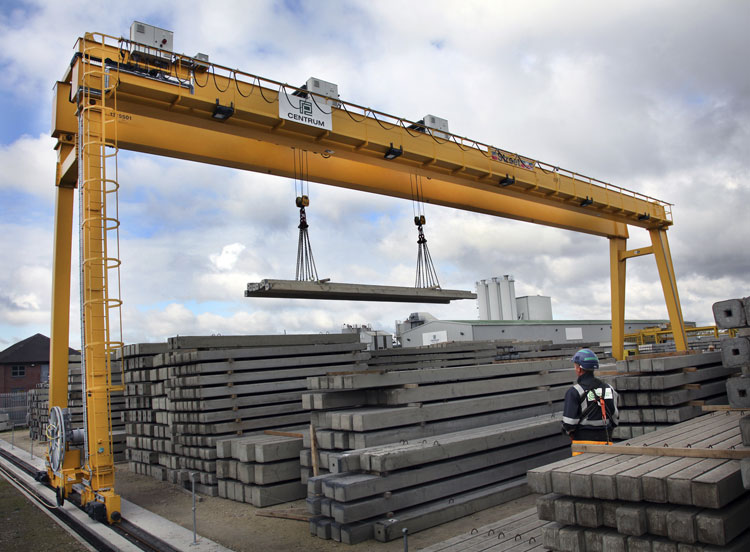If your industry involves working with or around cranes, especially heavy duty materials, you must get familiarised with and follow safety guidelines. Every crane type comes with its set of safety standards depending on its size, function, the facility it is used in and the application. Here we are going to tread upon the required safety standards for warehouse Gantry cranes that form a crucial part of how to use Gantry cranes.
Warehouse Gantry cranes are essentially overhead cranes on legs that run on floor-mounted rails generally installed in warehouses, workshops, material yards, factories, designed to position heavy materials with precision, improve efficiency and ensure safety. Just like all other types of cranes, warehouse Gantry cranes also come with their set safety standards.
Here are the basic operation and inspection safety points for such cranes. This involves complete inspection of the crane must be performed at intervals depending upon its activity, environment and intensity of service.
Visual Inspection
Before you turn on the power of your Gantry cranes, a thorough visual check by designated operators, must be a mandatory requisite to ensure timely repair and problem detection.
Visual inspection must be carried out daily, checked for damages on the components. The crane system must be checked for leakage and deterioration of lines, tanks, valves, drain pumps, and other parts of air or hydraulic systems. Scrutinise the wiring for any fraying or displacement, and whether it is properly and safely connected to the pendant. Another important component to check is Hooks. Look for deformation or cracks.
One thing that must be kept in mind is, that in case you spot any tags or ‘out of order’ signs, avoid operating the crane system. Ensure that it is thoroughly inspected and fixed before being put in use.
Functional Safety Test
The proof is in the pudding! The next pertinent step to ensure smooth and efficient functioning of your Gantry crane system is, to put it through function test. As you switch the power on, begin by activating all warning devices and wait for any detection of any kind of damage or malfunction. Each function must be tested, irrespective of the frequency of its use. All functional operating mechanisms such as Safety latch, load bearing rope, the ladder, platform, and walkway must be checked for maladjustments, cracks, weld marks and other signs of damage that might interfere with proper operation. Next, the hoist chains, including end connections, must be inspected for excessive wear and tear, twist or stretch beyond manufacturer’s recommendations.
Monthly inspection must be a vital part of the operations routine. It must entail a record of a certification that includes the date of inspection, the signature of the person who performed the inspection and the serial number, or other identifier, of the hook inspected.
Load Rigging
Despite a thorough inspection and pre-operation testing, Gantry crane operations can still pose serious dangers if the load is not rigged, secured or balanced correctly. Load rigging process requires adhering to the rated capacity of the sling, hook, and lifting devices, testing their load capacity, protecting the sling against operational hazards and selecting the correct sling angles.
Load Capacity
All cranes and lift systems are rated according to the maximum loads they can carry safely. Crane manufacturers must ensure that the ratings are posted on the equipment where they are easily visible. Overloading the Lifting equipment can lead to accidents and damage to the equipment. In case of even the slightest doubt about whether a load is too heavy, do not lift till you are absolutely sure it is within the rated capacity of the equipment.
General Safety Practices
Apart from the above mention practices that are indispensable to smooth functioning of the gantry crane system, here are some basic safety practices that must be kept in mind.
- A load must never be lifted over a worker.
- Workers must not be allowed to walk under a load being lifted or positioned.
- The load block must be returned to its designated location after use.
- The load block must not be low enough for someone to run into.
- The suspended load must never be left unattended.
- The unused slings must never be left suspended on a crane hook where there’s a chance it could become snagged.
- The crane must be transferred to a designated storage area.
- The equipment must be kept under continuous observation for any sign of problems during operation.
Operators’ Training
All workers/designated operators must be imparted with detailed and thorough training on the gantry crane system, especially warehouse gantry cranes, that are used in heavy movement areas in warehouses and factories. They must be injected with knowledge of the operating system, its functions, applications, and components.
Once all repairs have been completed, it must be ensured that the guards are reinstalled, safety devices are reactivated, and maintenance equipment is removed before restoring the crane to service.
